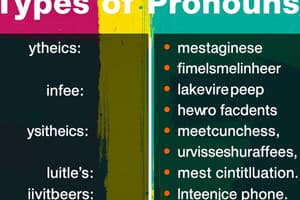Podcast
Questions and Answers
Which type of pronoun is used to refer back to the subject of the sentence?
Which type of pronoun is used to refer back to the subject of the sentence?
- Possessive Pronouns
- Indefinite Pronouns
- Reflexive Pronouns (correct)
- Demonstrative Pronouns
What is an example of a possessive pronoun?
What is an example of a possessive pronoun?
- who
- they
- itself
- his (correct)
Which of the following pronouns can be categorized as a demonstrative pronoun?
Which of the following pronouns can be categorized as a demonstrative pronoun?
- who
- everyone
- you
- these (correct)
Which pronoun is considered an interrogative pronoun?
Which pronoun is considered an interrogative pronoun?
In terms of usage, what is the primary function of subject pronouns?
In terms of usage, what is the primary function of subject pronouns?
What is a common error when using pronouns?
What is a common error when using pronouns?
Which of the following is an example of an indefinite pronoun?
Which of the following is an example of an indefinite pronoun?
What is the best practice regarding pronoun usage in formal writing?
What is the best practice regarding pronoun usage in formal writing?
Flashcards are hidden until you start studying
Study Notes
Definition of Pronouns
- Pronouns are words that replace nouns in a sentence to avoid repetition.
Types of Pronouns
-
Personal Pronouns
- Refer to specific persons or things.
- Subjective: I, you, he, she, it, we, they.
- Objective: me, you, him, her, it, us, them.
-
Possessive Pronouns
- Indicate ownership.
- Examples: mine, yours, his, hers, its, ours, theirs.
-
Reflexive Pronouns
- Refer back to the subject of the sentence.
- Examples: myself, yourself, himself, herself, itself, ourselves, yourselves, themselves.
-
Demonstrative Pronouns
- Point to specific things or people.
- Examples: this, that, these, those.
-
Interrogative Pronouns
- Used to ask questions.
- Examples: who, whom, whose, which, what.
-
Relative Pronouns
- Introduce relative clauses and relate to the noun.
- Examples: who, whom, whose, which, that.
-
Indefinite Pronouns
- Refer to non-specific items or people.
- Examples: anyone, everyone, someone, no one, all, some, few.
Usage of Pronouns
-
Subject vs. Object Pronouns
- Subject pronouns perform the action (e.g., I, she).
- Object pronouns receive the action (e.g., me, her).
-
Agreement
- Pronouns must agree in gender and number with the nouns they replace.
Common Errors
- Mixing up subject and object pronouns.
- Using incorrect possessive forms (e.g., its vs. it’s).
- Not ensuring antecedents are clear for pronouns, leading to ambiguity.
Special Considerations
-
Gender-Neutral Pronouns
- Options like "they" as a singular pronoun are becoming more accepted.
-
Pronoun Usage in Formal Writing
- Maintain clarity and formality; avoid using first-person pronouns excessively.
Summary
- Pronouns enhance clarity and conciseness in language.
- Understanding the different types and their correct usage is essential for effective communication.
Definition of Pronouns
- Pronouns replace nouns in sentences to prevent repetition.
Types of Pronouns
-
Personal Pronouns
- Specific references to people or things.
- Subjective forms: I, you, he, she, it, we, they.
- Objective forms: me, you, him, her, it, us, them.
-
Possessive Pronouns
- Indicate ownership without the noun.
- Examples: mine, yours, his, hers, its, ours, theirs.
-
Reflexive Pronouns
- Reflect back to the subject of the sentence.
- Examples: myself, yourself, himself, herself, itself, ourselves, yourselves, themselves.
-
Demonstrative Pronouns
- Specify particular items or individuals.
- Examples: this, that, these, those.
-
Interrogative Pronouns
- Employed to formulate questions.
- Examples: who, whom, whose, which, what.
-
Relative Pronouns
- Introduce relative clauses, connecting to nouns.
- Examples: who, whom, whose, which, that.
-
Indefinite Pronouns
- Refer to non-specific entities.
- Examples: anyone, everyone, someone, no one, all, some, few.
Usage of Pronouns
-
Subject vs. Object Pronouns
- Subject pronouns execute the action (e.g., I, she).
- Object pronouns receive the action (e.g., me, her).
-
Agreement
- Pronouns must match the gender and number of the nouns they represent.
Common Errors
- Confusing subject and object pronouns.
- Misusing possessive forms (e.g., its vs. it’s).
- Failing to clarify antecedents, which may cause ambiguity.
Special Considerations
-
Gender-Neutral Pronouns
- Singular "they" is increasingly accepted as a neutral option.
-
Pronoun Usage in Formal Writing
- Aim for clarity and formality; limit the use of first-person pronouns.
Summary
- Pronouns serve to improve clarity and brevity in communication.
- Mastery of pronouns and their forms is crucial for effective expression.
Studying That Suits You
Use AI to generate personalized quizzes and flashcards to suit your learning preferences.




